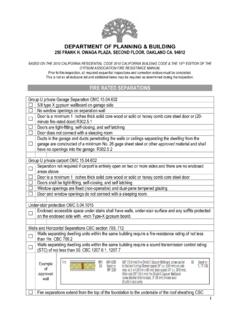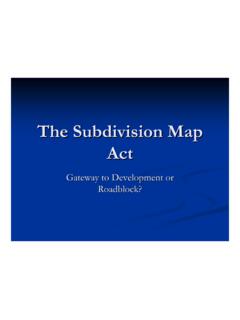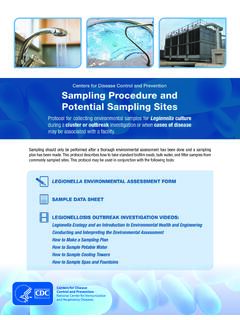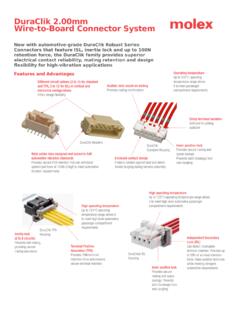Transcription of Water Heater Check List - Building in California
1 Water Heater Check List Lo-nox WH required per BAAQMD 8 ft. min. 12 in. min. above the roof deck (for roofs with slope < 6:12. Per energy code MECH-01, compliance doc required for permit & CF-6R required for final. 5 ft. min. above collar 6 in. min. to combustibles for single wall or 1 in. min. clearances for type B vent Expansion tank by Expansion tank when required. For explanation click here Vent adequately supported For sizing click here Expansion tank must be secured to structure Full-way valve Unions req. within 12 in. of WH. Insulate the first 5 ft. of hot &. cold Water per energy code. If recirc line installed, insulate all hot & recirc piping Flexible listed connector Relief valve within 6 in. of top of WH. Water Heater must be braced to resist displacement during Approved straps installed: earthquake top & bottom strap within1/3.)
2 Of top & bottom of WH. Solid support behind WH Bottom strap min. 4 in. at strap location to prevent above controls TPRV valve to movement drain to Listed gas shutoff valve outside of ahead of sediment trap Building 6 in. & gas connector Protective bollards to 24 in. above (only in garage) ground Drip tee or sediment trap (see below). Pipe supported to wall Illustrations by Paddy Morrissey courtesy of Code Check 2013* Page 1 of 6. * No copying, reproduction or publishing without the written permission of Code Check . Inquires to: Water Heater Checklist The intent of this Check list is to provide installers a general reference for the enforcement of code requirements in the City of Oakland. This checklist is for storage type Water heaters only. This checklist does not cover all the code requirements found in the plumbing code.
3 Be sure to Check with local jurisdictions for adopted local amendments and code updates. Unless otherwise noted, the following code excerpts apply to new and replacement Water heaters . It is important to note that an existing Water Heater is a Water Heater that was previously inspected and approved by the Authority Having Jurisdiction. It shall be unlawful for any person to install, remove, or replace or cause to be installed, removed, or replaced any Water Heater without first obtaining a permit from the Authority Having Jurisdiction to do so. (2010 CPC 503). The installing agency shall leave the manufacturer's installation, operating, and maintenance instructions in a location on the premises where they will be readily available for reference and guidance for the Authority Having Jurisdiction, service personnel and the owner or operator.
4 (2010 CPC ). Plumbing systems shall be installed in a manner conforming to this code, applicable standards, and the manufacturer's installation instruc- tions. In instances where the code, applicable standards, or the manufacturer's instructions conflict, the more stringent provisions shall prevail. (2010 CPC ). The installation of temperature, pressure and vacuum relief devices or combinations thereof, and automatic gas shutoff devices, shall be installed in accordance with the terms of their listings and the manufacturer's instructions. (2010 CPC ). Any Water system provided with a Check valve, backflow preventer, or any other normally closed device that prevents dissipation of build- ing pressure back into the Water main shall be provided with an approved, listed, and adequately sized expansion tank or other approved device having a similar function to control thermal expansion.
5 (2010 CPC ) Commentary: A Check valve or other normally closed device will create a closed system which requires an expansion tank. Inspectors will require an expansion tank when a Check valve is visible. A qualified plumber may further determine that the system is closed at non-visible locations through the use of tools and test equipment. Items such as Water meters and Water softeners and regulators sometimes have built-in Check valves. An approved expansion tank shall be installed in the cold Water distribution piping downstream of each pressure regulator to prevent excessive pressure from developing due to thermal expansion and to maintain the pressure setting of the regulator. (2010 CPC ). Commentary: This is a new requirement. Expansion tanks will be required on new construction homes that have a Water pressure regulat- ing device.
6 Expansion tanks must be properly sized and pressurized in accordance to the manufacturer's instructions. Pressure in Water systems is considered excessive when the pressure exceeds 80 psi. Damage can occur to Water heaters and other components in the Water system when they are subjected to excessive Water pressure. When Water is heated, it causes expansion and increased pressures in both the hot and cold Water piping system. In an open system, Water can only push back into the street provided that the street pres- sure is less than the expanding Water pressure. A properly sized and installed expansion tank protects the Water Heater and other Water system components from excessive Water pressure within the range of the regulator setting and the relief valve setting. Most warranties for plumbing fixtures and Water heaters become null and void when the products are subjected to excessive pressure.
7 A shutoff valve shall not be placed between the relief valve and the Water Heater or on discharge pipes between such valves and the atmo- sphere. The hourly Btu discharge capacity of the device shall be not less than the input rating of the Water Heater . (2010 CPC ). Relief valves located inside a Building shall be provided with a drain, not smaller than the relief valve outlet, of galvanized steel, hard- drawn copper piping and fittings, CPVC or listed relief valve drain tube with fittings that will not reduce the internal bore of the pipe or tubing (straight lengths as opposed to coils) and shall extend from the valve to the outside of the Building , with the end of the pipe not more than two feet nor less than six inches above ground or the flood level of the area receiving the discharge and pointing downward. Such drains shall be permitted to terminate at other approved locations.
8 Relief valve drains shall not terminate in a Building 's crawl space. No part of such drain pipe shall be trapped or subject to freezing. The terminal end of the drain pipe shall not be threaded.(2010 CPC. ). Discharge from a relief valve into a Water Heater pan shall be prohibited. (2010 CPC ). Residential Water heaters shall be sized in accordance with table 5-1. (2010 CPC table 5-1). Illustrations by Paddy Morrissey courtesy of Code Check 2013* Page 2 of 6. * No copying, reproduction or publishing without the written permission of Code Check . Inquires to: Water Heater Checklist Water heaters installed in residential garages shall be installed so that burners and burner- ignition devices are located not less than 18 . above the floor unless listed as flammable vapor ignition resistant. (2010 CPC ) Commentary: Since July 1st 2003, Water Heater manufacturers have been required to incorporate Flammable Vapor Ignition Resistant (FVIR) Technology into 30, 40 and 50 gallon gas Water heaters that are sold in the United States.
9 Water heaters with FVIR technology may be installed on the floor of a residential garage. Electric Water heaters do not have mandated FVIR technology and may cause a small spark when heating. Electric Water heaters should be placed on a stand unless documentation is provided by the installer/manufacturer that verifies FIVR construction. Water heaters shall be located or protected so they are not subject to physical damage by a moving vehicle. (2010 CPC ). Commentary: An acceptable bollard design consists of 2 or larger schedule 40 pipe, embedded 3 feet into the ground, encased in a 12 . diameter footing and filled with concrete. Flanged bollards, fastened with bolts to a concrete floor, wheel stops and elevating the Water Heater may also be acceptable when approved by the Authority Having Jurisdiction. Water heaters shall be anchored or strapped to resist horizontal displacement due to earthquake motion.
10 Strapping shall be at points within the upper one third and lower one-third of its vertical dimensions. At the lower point, a minimum distance of 4 inches shall be maintained above the controls with the strapping. (2010 CPC ). A Water Heater supported from the ground shall rest on level concrete or other approved base extending not less than 3 above the adjoin- ing ground level. (2010 CPC ). Water heaters installed in attics must have adequate support for the weight of the Water Heater . See the 2010 CRC section , the actual weights of materials and construction shall be used for determining dead load with consideration for the dead load of fixed service equipment. It is recommended to Check with the Building department for permit history and/or submittal requirements. When a Water Heater is located in an attic, attic-ceiling assembly, floor-ceiling assembly, or floor- subfloor assembly where damage results from a leaking Water Heater , a watertight pan of corrosion-resistant materials shall be installed beneath the Water Heater with not less than 3 4 diameter drain to an approved location.









